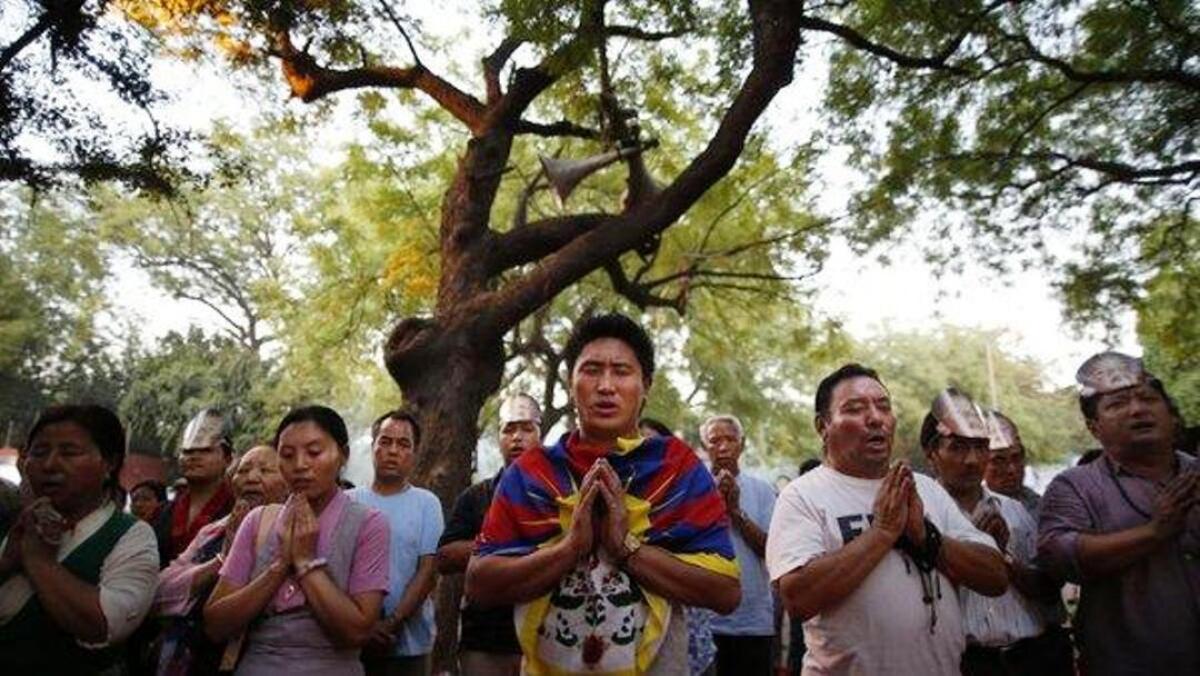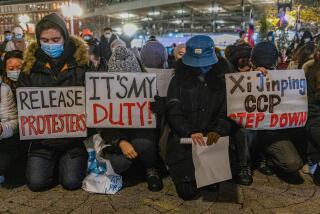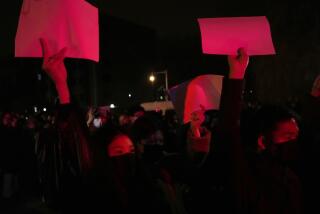Global Voices: Tibetan self-immolation soars with despair

- Share via
“Fire in the Land of Snow,” a documentary examining the spreading phenomenon of self-immolation protests in Tibet, provides the latest troubling chapter in the history of a solitary population inhabiting the Himalayan highlands known as the Roof of the World.
An empire of nomadic tribes and remote principalities, Tibet fended off covetous Asian armies for centuries before the new revolutionaries ruling the People’s Republic of China invaded in 1950 and embarked on a mission to force the agrarian Buddhists into communism’s industrial mold.
A 1951 treaty spelling out how power would be shared between Beijing and Lhasa swiftly unraveled amid violations and recriminations. In 1959, China abolished the autonomous Tibetan government after a failed uprising, chasing the Dalai Lama -- the Tibetan Buddhists’ spiritual leader -- and tens of thousands of his followers into exile.
Those left behind have chafed under Beijing’s yoke for more than half a century. As Mao Tse-tung pressed the Great Leap Forward and the Cultural Revolution, as many as a million Tibetans died of hunger, disease and abuse. Zealous Red Guards destroyed 6,000 monasteries across the subjugated mountain domain.
The Beijing government eased restrictions on Tibetans briefly during the 1980s, but that respite, along with other political reforms in China, ended with the Tiananmen Square crackdown in 1989. Since then, Tibet’s relations with the capital have reverted to a cycle of confrontation, with Tibetan protests spurring punishment, giving rise to more protest.
Since 2009, when Beijing tightened its administrative grip on the region following massive protests, at least 118 Tibetans have set themselves on fire in a public display of desperation. Once the rare, radical action of Buddhist monks sacrificing themselves for their religious and cultural heritage, self-immolation has lately been embraced by teenagers, women, intellectuals and workers in the prime of life.
In the hourlong documentary produced by Tibetan exile and Voice of America Tibetan Service director Losang Gyatso, “Fire in the Land of Snow” recounts recent Tibetan history and poses the question of why so many are choosing to protest “through one of the most painful and terrifying ways to die.”
Gyatso spoke with The Times about the film’s making and its message.
Q: Why is the frequency of self-immolation rising so dramatically? Is it a sense among the Tibetans that nothing else draws the outside world’s attention?
Losang Gyatso: It’s a combination of reasons. One is the further clampdowns on monasteries and the “reeducation programs” that have begun. The response of authorities has been to describe those who commit self-immolation as marginal people, disturbed people with problems. Tibetans have taken offense at this characterization as they see these as sincere actions over serious issues that have been unaddressed.
Q: Those who die in the act of self-immolation are celebrated as martyrs. Is that a driving force behind the increasing number of deaths?
Gyatso: It’s difficult to lump them all together as to motivation. Some are driven by the assaults on monastic life and religious practices. Some are taking action to protest language teaching changes – the substitution of Mandarin or Chinese for Tibetan as the teaching medium. Almost all had called for some easing of the crackdowns happening across Tibet. In the testimonies left behind by some – the poetry and the recordings – they all demand freedom and ask for the return of the Dalai Lama. I don’t think there is a sense in the Tibetan community of self-immolation as a kind of cult. This form of protest was preceded by years of writers and artists trying to express dissent and Tibetan identity in a more traditional way.
Q: With journalists largely prevented from visiting Tibet, how do you go about getting visual images from the region?
Gyatso: With great difficulty. What photos and pictures and video that exist today of self-immolation or the security buildups in Tibet, the images used in the film, came from individuals who took great risks to get them. They are from cellphones, primarily. Some of the footage in the film, of the security in a village outside Lhasa showing people being beaten, that actually came from Chinese security footage that leaked out.
Q: What do you think China fears about a more open and autonomous Tibet?
Gyatso: The film doesn’t try to draw conclusions as to what the fears are that Beijing has. There is the view expressed that perhaps there is a disconnect between Beijing and the leadership in power in Tibet. Some of these regional leaders have a lot to lose if there is legitimate resolution of the Tibetan issue. The whole idea of there being a separatist movement fueled from outside served to bring in funds from the central government that they used to further implement policies that Tibetans resent. It’s cyclical in nature.
Q: Do Tibetans want independence from China?
Gyatso: The Dalai Lama has made clear from the mid-1980s that he was not pursuing independence for Tibet, that he is pursuing a policy that sees Tibet within the Chinese constitution and the Chinese state. But this Tibet must have a larger say in its religious and cultural and linguistic affairs. It’s wrong to say that all would be happy with a solution within China, but they would accept the Dalai Lama’s position.
Q: The Dalai Lama is almost 78 and has been outside Tibet for more than half a century. What is the plan for transition to the next spiritual leader for Tibetans?
Gyatso: The Dalai Lama has said that he was open to various ideas for succession. But he has also said the Tibetan issue exists apart from him and will continue to do so.
Q: China’s rulers also have difficult relations with the Muslim Uighurs and the Christian sects and adherents to Falun Gong Buddhism. Do they have a general policy of repression toward minority religions?
Gyatso: There are some shared experiences with the Uighurs and others. But Tibet brings up other issues. It is a society and a nationality and an entire region that had a treaty agreement with Beijing and a unified existence as a state for centuries.
Q: What is day-to-day life like in Tibet?
Gyatso: The overwhelming majority of Tibetans lead rural, agrarian lives. Quite a large percentage, about 20-25%, were nomadic, traditionally. But the nomads have had a very difficult time of it over the past decade. Their pastures were cordoned off and they were forced to sell their animals and move into housing units. It’s been the closing off of a whole way of life, not just a means of earning a living.
Q: China’s main media have given scant coverage to the self-immolation incidents. What do you think would be the reaction of other Chinese citizens if they were aware of the repressions driving Tibetans to such extreme protests?
Gyatso: The way the situation is presented on CCTV leaves no doubt that the average Chinese viewer would see the protests as another instance of the ungrateful Tibetans rioting. If they had unfettered access to information about what is happening in Tibet over the last 50 years, the cultural and human rights issues Tibetans are facing, I am sure the thinking Chinese person would see cause for concern and the need for remedies.
Q: Most of the sources interviewed in the documentary are far outside of Tibet. How are they able to keep up on developments in the region?
Gyatso: The lines of communication vary, year to year, month to month, depending on Chinese policies. Generally, the people we spoke with in the film have kept up to date with happenings in Tibet for their profession and for their passion. You can’t find a group of people more in tune with what is happening inside China than those following Tibetan issues.
Q: What do you see as the prospect for some resolution of this standoff that has persisted for more than half a century? Will Beijing eventually ease up on Tibet?
Gyatso: As remote as a resolution might seem today, if some boldness and vision on the part of the leadership in Beijing were to emerge, it’s possible. Many of the points within the 17-Point Agreement the Chinese authorities signed with the Tibetan government in 1951 reflect the main ideas in the Dalai Lama’s proposal for genuine autonomy for a Tibet within the Chinese state, and that therefore a solution to what appears to be an intractable problem is not as far off as it seems if Beijing were serious in resolving the issue.
More to Read
Sign up for Essential California
The most important California stories and recommendations in your inbox every morning.
You may occasionally receive promotional content from the Los Angeles Times.











